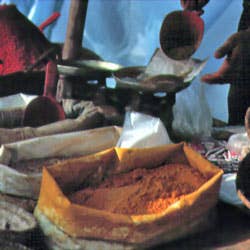
Basics of Moroccan Food
(Adapted from Paula Wolfert's _Couscous and Other Good Food from Morocco, Perennial Library, 1987.)_
Moroccan cooking, part Arab and part Berber, is not at all like the food of the Middle East. Its ingredients and cooking styles are unique; no other Arab country has such a rich and varied cuisine. In the south, you sense a strong African influence; in the north, many borrowings from Andalusia. The play of sweet against spicy, and the combinations of meat and fruits, recall Persia and Catalonia.
Wandering among Morocco's spice stalls—past the saffron, the cinnamon, the rich, earthy cumin seed, the pungent powdered ginger, the licorice-scented anise—you may well think the Moroccans have fallen in love with every spice in the world. In fact, the country's cooks have a deep understanding of how spices should be used: to stretch the taste of foods, pushing them to a certain point without destroying their inherent flavors.
The truly classic Moroccan specialties include a medley of grain dishes known collectively as couscous; mechoui (spit-roasted lamb scented with cumin); bisteeya (a flaky, layered, sweet-and-savory pastry); a vast number of vegetable dishes cooked in olive oil; and the huge, extraordinary repertory of traditional and regional stews called tagines. Tagines of meltingly tender meats cooked with assorted spices and smothered in legumes, vegetables, or fruits are the mainstay of most Moroccan meals.
Most Moroccan food is made of humble things: tomatoes, peppers, pumpkin, olive oil, herbs, spices, eggs, honey, grains, couscous, legumes, fragrant waters. There are certain components essential to real Moroccan cooking: preserved lemons, preserved butter (called smen), olives pickled with aromatics, and vegetables preserved in brine or in raipe (a kind of yogurt in which milk is thickened by an element in the hairy centers of wild artichokes). There are also the delicious preserved meat called khlea, various yeast-raised breads, and the onionskin-like pastry leaves called warka used for bisteeya—which is the traditional first course at marriage feasts, circumcision celebrations, and luxurious Moroccan diffas, or banquets.
Moroccan salads are not salads in our sense—mixtures of greens, doused with dressings. More like Italian antipasti, they are dishes of spiced or sweetened, cooked or raw vegetables, served at the beginning of a meal to inspire the appetite and refresh the palate. The glories of these salads are their unexpected contrasts: carrots with cumin and hot paprika; zucchini flavored with wild herbs; orange sections with thin slices of artichoke bottoms; stewed lamb's brains with preserved lemons; or—one of the best—eggplant and tomato cooked down to jam, which is utterly delicious on dense Moroccan bread.
Bread is very important in Moroccan dining, both as food and as an implement for grasping hold of meat or vegetables, swirling them in the gravy of a tagine, and then transporting them to the mouth. I find that Moroccan food always tastes better when eaten Moroccan-style, with the first three fingers of the right hand. The contact between fingers and a hot tagine, fingers and a crisp bisteeya, fingers and a tender mechoui, always adds to the pleasure. I urge everyone to eat a Moroccan dinner this way.
Keep Reading
Continue to Next Story










